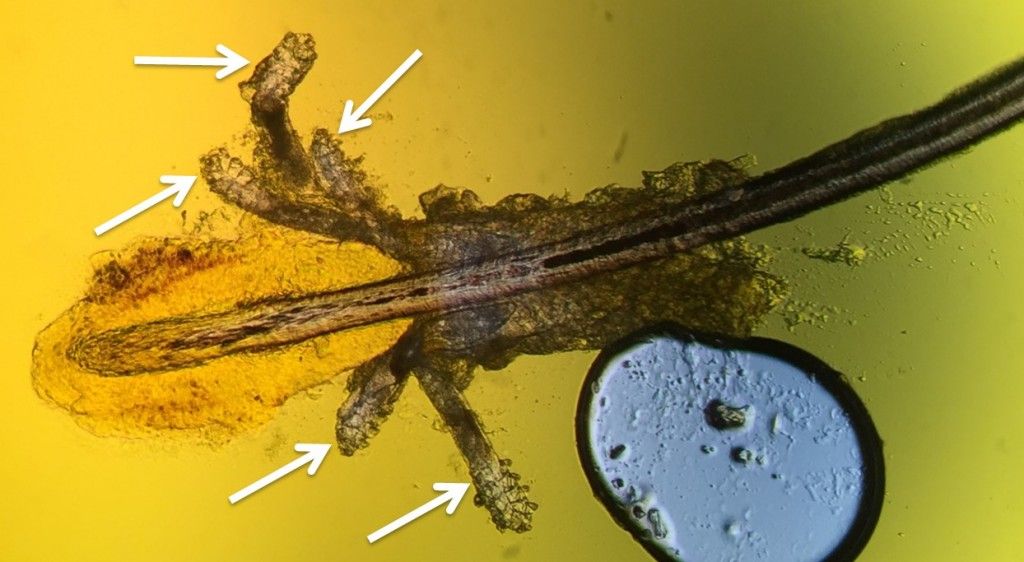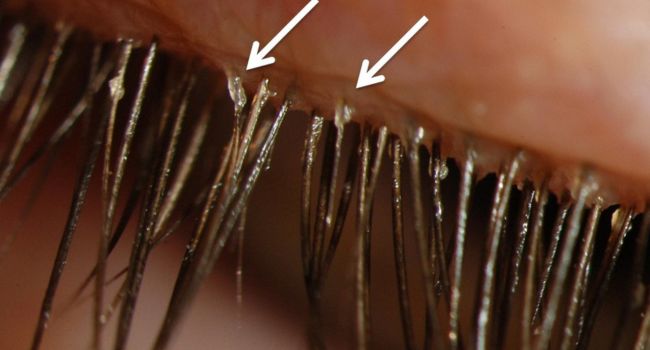In the world of beauty and skincare, our quest for radiant and captivating eyes often leads us to explore various aspects of eyelash health and enhancement. But did you know that there are tiny creatures called eyelash mites that live on our eyelashes? They might be small, but they’re important to know about for keeping our eyes healthy.
In this article, we’re going to learn all about eyelash mites: what they are, where they come from, the symptoms they might provoke, and the remedies for their treatment. So, let’s explore the world of eyelash mites and learn how to take care of our eyes!
What Are Eyelash Mites?
Eyelash mites are microscopic parasites that inhabit or are near the hair follicles of humans and other mammals.
It might seem concerning, but a small quantity of these mites exists in the creases and borders of our eyelids. They remain hidden within hair follicles during the daytime and emerge at night for activities like feeding, egg-laying, and waste elimination. These mites make up a natural part of our body’s microbiome and actually play a beneficial role by eliminating deceased skin cells and excess oils.
In most cases, these tiny organisms do not cause any harm. However, specific cases, such as a clogged oil gland providing ample nourishment, can trigger the reproduction of mites. Their populations also tend to increase with advancing age. When an excessive number of these minuscule parasites are present, they can contribute to ocular and dermal issues.

Eyelash mites can reside in your eyes without your awareness, often favoring oily areas and consuming dead skin cells and skin debris. Our body hosts two types of lash mites:
- Demodex folliculorum: located on the hair follicles of the eyelashes They are usually around 0.3 to 0.4 millimeters in length. Demodex folliculorum mites are known to play a role in various eye and skin conditions.
The presence of Demodex folliculorum mites on the skin has been linked to rosacea, an inflammatory skin condition that leads to redness, flushing, and sometimes the development of small red bumps. Not only that, these mites have also been found to infest the eyelashes and contribute to the development or exacerbation of blepharitis, an inflammation of the eyelids that can cause redness, irritation, itching, and flaking of the eyelid skin.
- Demodex brevis: These mites are smaller, measuring about 0.15 to 0.2 millimeters in length, and are found deeper within the sebaceous (oil-producing) glands of the eyelids.
Demodex brevis mites also contribute to certain eye and skin issues. Demodex brevis mites can cause folliculitis, an inflammation of hair follicles, by inhabiting and clogging the hair follicles and sebaceous glands.
Another condition that Demodex brevis can trigger is Meibomian Gland Dysfunction (MGD). MGD is a condition where the meibomian glands in the eyelids, responsible for producing the oil layer of tears, become blocked or dysfunctional. Demodex brevis mites living within these glands can contribute to blockages, affecting the oil flow and leading to dry eye symptoms and discomfort.
Both types of mites have a natural life cycle involving egg, larva, nymph, and adult stages. While these mites are generally considered a normal part of the human microbiome, they can sometimes overproliferate and lead to various symptoms and discomfort, especially when their population increases significantly.
What Causes Eyelash Mites?
Demodex mites are most commonly found on the facial region and can easily spread through close physical contact between individuals. Factors leading to the presence of eyelash mites include:
- Close Contact: Eyelash mites can be contracted through close or direct contact with an individual who has them. The infested person might harbor both larvae and mature mites that can transfer to others.
- Personal Hygiene: Inadequate hygiene practices can create an environment conducive to mite growth. Regular and thorough cleansing practices can help prevent these tiny parasites from thriving
- Age: The probability of having an excessive number of eyelash mites also increases if you are an elderly individual, a caregiver for the elderly, or if your immune system is compromised due to a health condition or medication.
- Sex: Oddly enough, men are more likely to experience demodicosis than women. This could be because women frequently use eye makeup and regularly cleanse their eyelids afterwards.
- Poorly Managed Eye Conditions: Certain eye conditions, such as blepharitis, can contribute to eyelash mite proliferation.
- Environmental Factors: Exposure to dust or contaminated surroundings containing mite eggs can lead to infestation.
What Are The Symptoms Of Eyelash Mites?
These symptoms can be observed as a result of Demodex mites:
- Dryness of the eye
- Itchiness
- Blurriness of vision
- Sticky or crusty eyelashes after waking up
- Red, crusty edges on the eyelid
- Teary eyes
- Swelling of the eyelids
In more severe instances, the following symptoms might appear:
- Conjunctivitis
- Burning sensation
- Presence of unusual-looking eyelashes
- Loss of eyelashes
More serious symptoms may result in inflammation of the eyes, a condition known as blepharitis. This can trigger other symptoms such as crusty eyelashes, sticky eyes, and increased blinking. Over the long term, blepharitis could also contribute to the abnormal growth of eyelashes.

If your doctor suspects that eyelash mites may be contributing to these issues, they will inquire about your symptoms and inspect for redness or inflammation along the eyelid edges. Additionally, they will aim to rule out different conditions that could lead to eye irritation.
How To Treat Eyelash Mites
The National Eye Institute proposes the following home remedies:
- Gently cleanse your eyes using water, baby shampoo, or other mild cleansers.
- Wash your eyes at least two times a day.
- Delicately remove the crust from your eyes through gentle scrubbing.
- Soak your eyelids in warm water to remove the crust from your eyelids.
- Refrain from using eye makeup until the infestation has resolved.

Using home remedies as well as medical interventions is likely to resolve an eyelash mite infestation within a few days. For mild cases, over-the-counter medications or home-based solutions can be considered. Simple remedies, such as diligent cleansing of the eyes and face multiple times daily, can treat most cases of eyelash mites. However, in more stubborn cases, opting for medical treatments can offer rapid alleviation.
We recommend the following medical remedies:
Prescription Medications: Doctors may prescribe topical or oral medications, such as antibiotics or antiparasitic agents, to directly target and eliminate the mites.
Antibacterial Ointments: Applying antibacterial ointments or creams can help control the mite population and manage associated symptoms.
Anti-Inflammatory Medications: Inflammation caused by mite infestations can be addressed with anti-inflammatory drugs, reducing discomfort and promoting healing.
Demodex-Specific Products: Some specialized products, formulated to target Demodex mites, may be recommended by healthcare professionals.
Tea Tree Oil: According to research about: “Demodex blepharitis: clinical perspectives”, Stephanie R Fromstein et al. indicate that tea tree oil might be the only way to eliminate Demodex mites. Its potential antibacterial, antifungal, and anti-inflammatory properties may contribute to addressing the issue effectively. Remember to dilute tea tree oil when used near the eyelid or eye area; otherwise, it can lead to irritation, redness, and swelling.

And of course, It’s crucial to consult a medical professional for a proper diagnosis and personalized treatment plan based on the severity of the infestation and individual health considerations.
>> Read more: Dealing With Itchy Eyelash Extensions: Causes And Remedies
What To Avoid When You Have Eyelash Mites
While eyelash mites are typically non-contagious, it’s important to exercise caution. Therefore, be cautious if you or someone close to you has eyelash mites.
For serious cases of lash mites, consider the following:
- Minimize close contact with others.
- Refrain from sharing eye makeup, including mascara and eye shadow brushes, as well as any cosmetics that come into contact with the eyelash or eyelid.
- Avoid rubbing or scratching the eyes.
- Steer clear of oily makeup and lotions.
- Wash all bed linens and sheets in hot water.
- If you live with someone experiencing a severe eyelash mite issue, seek an evaluation, as you may also be affected.
Should you feel noticeable discomfort, seeking treatment is essential. If addressed early, eyelash mites are easily manageable and unlikely to cause lasting changes to vision or eyelid health.
Treatment aims to eliminate adult mites, prevent further reproduction, and alleviate symptoms. In most cases, eyelash mites can be effectively treated over the course of a few weeks.
Conclusion
As we draw the curtain on our exploration of eyelash mites, we’ve learned some important things. These tiny creatures may seem small, but they play a big role in our eye health. By understanding where they come from, what they can cause, and how to treat them, we’ve gained the power to take better care of our eyes and make them both beautiful and healthy. So, remember, keeping our eyes happy is just as important as making them look beautiful!
More updated information: https://vietnamlash.com/


